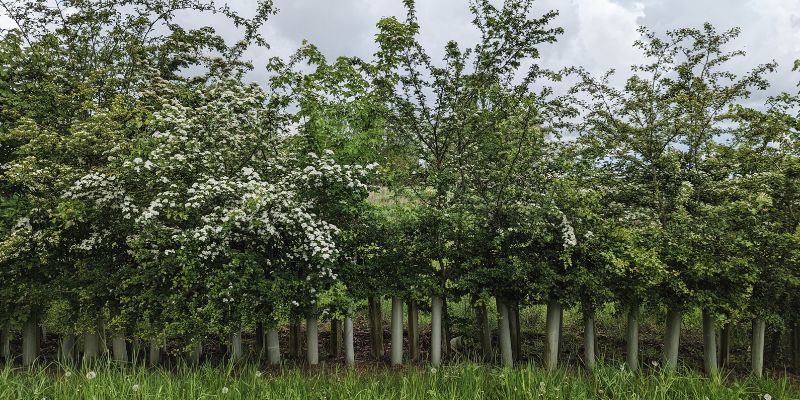
Planting hedgerows increases soil carbon storage by almost half compared to nearby grassland – no matter where they are in the country – says new research.
A team led by scientists from the University of Leeds analysed soil samples from nine farms across five locations in Yorkshire, Cumbria and West Sussex, to find out how carbon storage under hedgerows compared to that found in adjacent grass fields.
They found that the soil under hedges stored on average 40 tonnes more carbon per hectare than managed grassland in all locations and that this did not vary due to differences in soil type, rock formation and climate across England. Their results are now published in the journal Agriculture, Ecosystems & Environment.
Planting hedgerows can have a positive impact on soil health and the soil carbon storage all around the country.
In addition to carbon storage, hedgerows offer many environmental benefits. They connect vital habitats throughout farmland and provide refuge and food to plants, wildlife and livestock.
Hedge planting has been widely encouraged as a way to meet the UK’s environmental targets. The UK Government has announced its goal of planting 72,500 kilometres of hedges throughout England by 2050, while the UK Climate Change Committee has proposed increasing the hedge network by 40% by 2050 to help mitigate climate change.
In 2024, the government published hedgerow management legislation which requires landowners to maintain a ‘buffer’ of two metres between hedges and farmland, in which they can’t use pesticides or fertilisers. It also implemented a hedgerow cutting ban over the summer months.
This research, which is the first to identify that hedgerows’ increased soil carbon stocks are the same across England, underlines the importance of these actions.
Dr Sofia Biffi, Research Fellow in agricultural ecosystems, said: “We are very happy to share the results of our work, because they show how planting hedgerows can have a positive impact on soil health and the soil carbon storage all around the country.
“In the past few years, we have witnessed how farmers are engaging with hedge planting. They can see the difference that hedges make to the biodiversity on their farms. They see more birds, bats, and pollinators, and they enjoy their flowers, wood, and shade. And now they can also know that they are playing their part in storing more carbon in the soil.”
James Robinson is a Cumbrian dairy farmer and England Chair of the Nature Friendly Farming Network, which advocates for sustainable farming and food production in the UK.
He said: “It’s good to have the science to back up what we farmers already know, which is that there is an ever-growing list of reasons to plant and manage hedgerows, from livestock health, crop protection and biosecurity, through to carbon storage.
“Hedgerows should be seen as a huge asset both to farmers and the landscape and if we manage them in the right way, using traditional hedge laying techniques, we can make them an eternal feature of our rural landscape.”
The five locations analysed in the study were chosen for their differences in climates, rainfall, temperatures and soil types. They consisted of intensively managed, fertilised pastures with hedges around them, and used for grazing livestock and cutting for silage. The team used a corer to sample soil at 10 cm intervals up to 50 cm under the grass and hedges, and compared their carbon, nitrogen, pH and moisture levels in a laboratory.
They found that, due to falling leaves, roots and other organic matter being incorporated into the soil, the hedges stored more carbon than the grassland sites. Older hedges stored greater amounts of carbon than younger hedges. At the same time, they found that hedges reached an upper limit of how much carbon they could store.
As the soil under older hedgerows stores the most carbon, and this carbon is vulnerable to decomposition, it’s essential to protect existing hedgerows to stop the carbon being lost to the atmosphere. However, it’s also important to plant new hedges to increase the carbon sequestration capacity of hedges across the country.
Professor Pippa Chapman, co-author of the study and Chair in Biogeochemistry at the University of Leeds, said: “We have seen some important hedgerow planting commitments from the government, which we hope they will support farmers to achieve in the next few years. It is not only hedgerow planting that brings so many benefits to farmland but also maintaining the network of hedges and hedgerow trees that we already have.
“If a hedgerow is removed, the additional carbon stored in the soil quickly disappears into the atmosphere. So planting, gapping-up, and hedge laying are all important actions that farmers can take to help protect the carbon stored in soil beneath hedges and the environment.”
The team, which included researchers from the School of Geography at the University of Leeds and the School of Biosciences at the University of Sheffield, believe the data recorded in the study could be used to predict the impact of planting new hedgerows on the UK’s net zero targets.
Further information
For media enquiries, please contact kersti Mitchell via k.mitchell@leeds.ac.uk